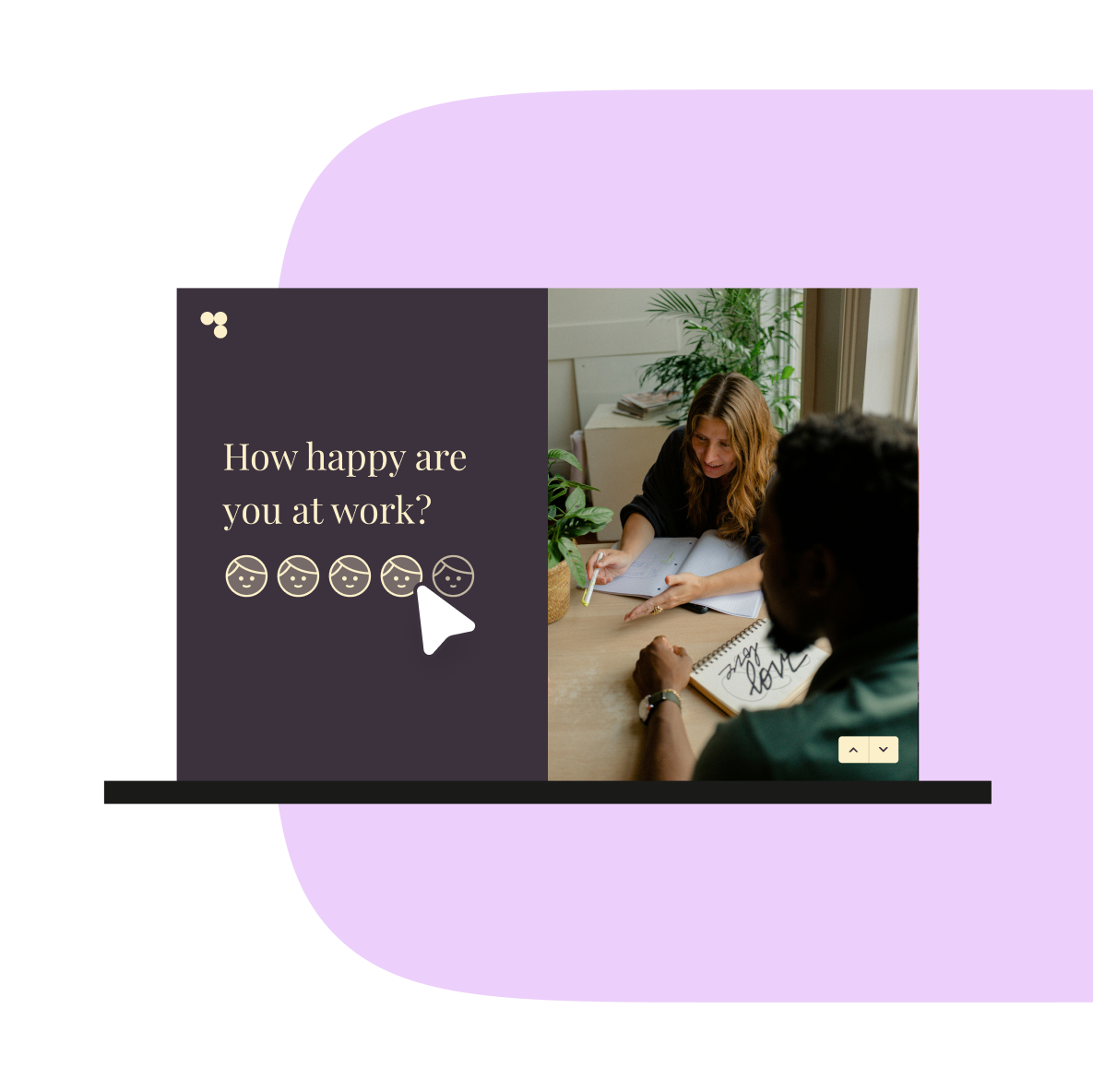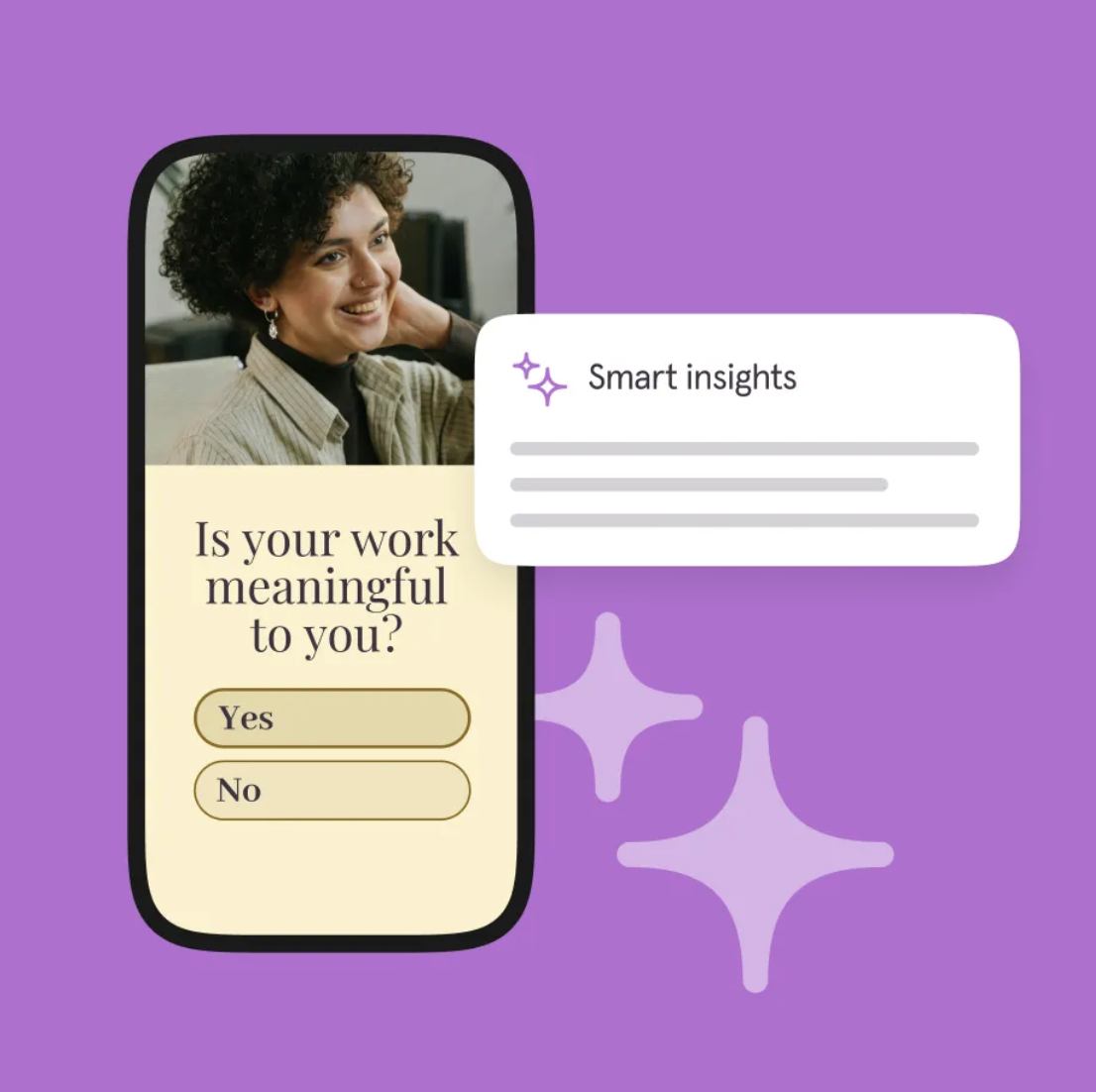The future of employee engagement: From campaigns to relationships
The future of employee engagement isn't about more surveys—it's about building relationships, not campaigns. See how to scale and personalize engagement so employees feel heard, valued, and connected to your organization.

Contents
It seems like you can't escape the endless TikToks about employees feeling unmotivated at work, experiencing burnout, or staying at jobs they're unhappy with to avoid navigating the uncertain job market.
And the data backs up these claims, namely, with how unengaged employees are. Gallup's State of the Global Workplace: 2025 Report found that in 2024, employee engagement dropped to a staggering 21%—the lowest in 12 years. And that drop cost the global economy $438 billion in lost productivity.
The common thread? Employee engagement. Sounds easy, right? And that's the issue. The problem isn't unengaged employees—it's that you've made them feel like their voice doesn't matter.
And because their voice doesn't matter, they're unwilling to share valuable feedback. That employee feedback culture you're trying to create feels inauthentic because feedback feels like a data point, a metric—not an opportunity to build long-term trust with employees.
Plus, they're tired. Survey fatigue is real, and they don't want to fill out yet another engagement survey. But here's the thing: the biggest cause of survey fatigue isn't volume, it's the perception that you won't act on the feedback.
Employees share valuable insights, but nothing changes. They disengage. That annual survey or pulse check becomes an annoying task they rush through. And slowly, the trust your employees had erodes with every meaningless survey.
Your employees don't want more surveys—they want to feel heard, valued, and connected. And they want an ongoing relationship. Not a once-a-year campaign.
The future of employee engagement relies on building trust through continuous, relationship-based conversations.
Ready to rethink your approach to employee engagement? The payoff could be big. Gallup estimates that we could add $9.6 trillion in productivity to the economy if the global workforce was fully engaged. It starts with one shift: engagement as a relationship, not a campaign.
I’m Emmaka Porchea-Veneszee, the chief of staff here at Typeform. I’m exploring how savvy organizations are shifting from campaign-driven engagement to relationship-based connections, including:
- How employee engagement has evolved
- What companies get wrong when trying to create a listening culture at work
- How you can drive scalable employee engagement
How has employee engagement evolved over the past few years?
The biggest shift in employee engagement is that it's no longer a once-a-year survey—it's an always-on expectation that many organizations weren't ready for. And remote work only accelerated that shift.
When teams were distributed across the globe, organic engagement was no longer an option. It had to be intentional. Collaboration became a necessity—from Zoom calls to project-based Slack channels. Teams had to be proactive about staying connected to their colleagues and the business.
And for a while, that drove engagement up from pandemic lows. People adapted and found new ways to work together. Then the novelty wore off, hybrid work became the new norm, and engagement dipped yet again.
Why? Because businesses stuck with the old playbook. Employee engagement strategies were built around annual surveys, but the modern employee experience requires a new approach—one that's continuous, not a one-off.
Looking back, employee engagement was predictable—send out the annual survey, share the results in an all-hands meeting, maybe act on some of the feedback, repeat the process. It was transactional.
Now? Leaders know a campaign approach won't cut it. So you’ve added regular feedback and pulse surveys, Slack polls, and even feedback tools that make it easier than ever to engage employees. Despite these efforts, employee engagement is still low. Here's why:
You're treating feedback as an always-on task, but you're not changing how you ask or what you do when you get employee feedback.
AI has made it quick and easy to create, deploy, and analyze employee satisfaction at scale. But it's also stripped the humanity. It feels mechanical.
Employees get a link, fill out the form, and then... silence. You've automated the entire process, making it all perfectly optimized and cold. And that's what employees are feeling: more tasks, less humanity.
What do you look for to signal that a team’s truly engaged?

At Typeform, our most engaged employees are those who are extremely locked in—they're proactive, they've thought three steps ahead, and they're coming up with solutions to anticipated problems.
They embrace ownership and hold themselves accountable—for the wins and the losses—especially in tough environments. But individual employee engagement is only part of the story. The bigger indicator? Psychological safety.
When you foster open communication and employees feel safe enough to express their thoughts—to challenge ideas, push back, or raise concerns—you know you’ve got an engaged team. You've built trust and created an environment where employees feel heard.
At Typeform, we have ongoing initiatives, and our employees feel safe to respectfully question priorities. Instead of brushing it off, our leadership team embraces input and provides solid direction and solutions to address concerns.
Not only does this create psychological safety, but it also strengthens trust across the company.
And you amplify that trust when leadership addresses feedback with real solutions—even if not immediately. That's what drives employee engagement.
What do most companies get wrong about employee engagement?
Employee engagement isn't one-size-fits-all. Yet most organizations treat it that way—HR sends the same tired annual surveys on the same rigid schedule—no matter what's going on in the business or employees' lives.
The problem with a cookie-cutter approach is that you’re trying to uncover insights without crucial context. Asking for feedback from employees right after layoffs? During a stressful product launch? In Q3, when they’re burnt out? Context matters.
For example, Typeform is based in Barcelona, with teams around the world. We can’t send out a standard employee feedback form that ignores the different cultures and experiences across regions, teams, departments, and seniority levels.
What works for one team might not work for another.
Then there's the format. Do you always send surveys with Yes/No and rating questions only? If employees see the same thing (and know you won't act on their feedback), they won't bother filling out the survey. Consider changing up the format or adding more engaging video questions.
And here's the bigger miss: not getting buy-in from employees. Sharing surveys that no one asked for gets rushed responses or skipped surveys altogether. Instead, let employees know that engagement matters and ask them what changes you could make to get them to engage:
- What format feels authentic to them?
- What timing makes sense?
- When do they feel most heard?
Let them shape the process and show them employee engagement isn't just another corporate initiative—it's a genuine relationship.
How to get employee engagement right

The old playbook isn't working. So what does a future-ready employee engagement strategy actually look like?
Hint: It's all about making engagement more relational than campaign-focused.
Tip 1: Engagement needs to be scalable
One-on-ones are table stakes for building relationships with your employees, but they can't be your only employee engagement strategy. It's simply not scalable.
As you grow to hundreds—or thousands—of employees, especially across distributed teams, you need a convenient way to gather feedback asynchronously. That doesn't mean you have to lose the human touch or create a cold, robotic experience.
At Typeform, we use our own product to keep employees engaged, no matter where they are in the world. I recently opened a Typeform where our CEO recorded a video introduction—it built an instant connection and made the whole experience feel genuine.
And then getting the option to respond on video? That made it feel truly like a conversation. But it was also scalable. This human-first approach to employee engagement makes it feel fulfilling—not exhausting.
Instead of an annual survey, it felt like the start of an ongoing conversation, not a one-off data collection exercise. And we carry that practice over to culture, too. We use Typeforms to scale culture—a crucial part of employee engagement—across time zones, roles, and teams.
From personalized onboarding and retros to offsite feedback and manager check-ins, we create intentional touchpoints throughout the employee journey that make sure everyone feels included and heard—no matter where they are in the world or their career.
Pro tip: Create a single Typeform and use features like conditional logic and recall to personalize feedback at scale without needing dozens of different forms.
Tip 2: Personalization is a non-negotiable
One-size-fits-all surveys with zero personalization send your teams a clear message: every one of you is an interchangeable data point. Not the message you want to send out.
True personalization is about more than simply calling an employee by name in a survey—you need to ask questions that are actually relevant. Like asking new hires tailored questions about onboarding, expectations, and sharing resources, but skipping these for your veteran staff.
At Typeform, we understand that one-to-one conversations aren't scalable across an organization with hundreds of employees. That's why we balance personalization and that conversational feel with consistency:
- We use the same structure across teams, but tailor the questions. Everyone gets a pulse check-in, but the questions adapt to what's relevant for their role, department, or tenure. It's consistent enough to track trends, but personalized enough to feel genuine and foster employee engagement.
- We follow up on data with targeted surveys. If our pulse checks reveal that one team—like sales—is showing higher burnout, we don't just note it and move on. We create a follow-up survey specifically for that team to understand what's driving their burnout and what would help.
- We treat surveys as conversation starters, not endpoints. When someone shares feedback that needs clarification or raises a red flag, we follow up. Sometimes it's with a one-on-one or a deeper-dive survey. It shows employees we're not just collecting data—we're listening.
When you personalize your surveys, employees see you asking questions that matter to their specific situation, and they know you're doing more than simply checking a box. You're genuinely trying to understand their experience.
Tip 3: Listening is a leadership strategy
Intentionally building a listening culture at work requires more than collecting feedback. You need to acknowledge it, address it, and bring employees into the solution. Real listening invites conversation, offers transparency, and closes the loop by showing employees what’s changed.
Telling your teams you've listened to their feedback is one thing. The next step is to start a dialogue and come up with a solution that addresses your staff's concerns.
At Typeform, we treat listening as a leadership responsibility, not just an HR task:
- We're transparent about what we're hearing. In our bi-weekly all-hands, leadership shares real-time updates on feedback themes and how we're addressing them. We have open Q&A sessions so employees can push back, ask questions, and challenge our approach. Feedback becomes a two-way conversation instead of a presentation.
- We look at feedback holistically. Instead of treating each survey as a one-off, we continuously review the story our employees are telling. What's changing? What trends are emerging? We can then respond with solutions—using that data instead of it just sitting in a dashboard, unacted on.
- We make employees feel the changes. We embed employee engagement into everyday work—manager check-ins, team retros, and ongoing Slack conversations. We invite employees to co-create solutions, turning feedback into a team effort rather than a top-down mandate with no real buy-in.
When employees see feedback turn into tangible change—and when they're part of that process—they feel heard and invested in building a better workplace.
Pro tip: After acting on feedback, send a follow-up Typeform showing employees what's changed and asking if the solution is working. It proves you didn't just listen—you acted, and you're still listening.
The new employee engagement tech stack
You don't need a bloated tech stack to improve employee engagement. You need the right tools—ones that create conversations, not transactional data exchanges. Here’s what’s working and what isn’t:
Out: Static, one-size-fits-all survey tools
In: Dynamic feedback platforms
Basic employee engagement surveys don't account for the unique experiences or nuances of your teams. The result? Surface-level responses that don't give you the full picture. But modern engagement tools, like Typeform, help you personalize feedback forms for each employee.
With conditional logic, a one-question-at-a-time flow, and an engaging experience that feels tailored, employees share richer, more relevant feedback—the kind that makes them feel heard and provides invaluable insights to create a better workplace.
Out: Once-a-year surveys
In: Continuous feedback layered into real workflows
Want engaged employees? Engage them more than once a year. It should happen at crucial employee moments, like:
- Onboarding
- After major announcements or leadership changes
- Post-product launches
- During manager check-ins
At Typeform, we embed feedback opportunities throughout the employee lifecycle. We change up the format—video responses, open-ended questions, quick pulse checks—and let our people know that there's a purpose—it's not just a task on their list.
Out: Surface-level insights that don't tell the full story
In: Qualitative insights combined with engagement data
eNPS scores and rating scales tell you what employees feel, but not why. You get surface-level insights but not enough context to really understand the whole story.
That's where open-ended questions, video feedback, and follow-up questions come into play. They give you the story behind the numbers—and that's what drives meaningful action.
How we use Typeform at Typeform

Wherever we can use Typeform to gather feedback—from off-site feedback to post-meeting reflections to pulse surveys—we do. It lets us scale personalized, conversational engagement across our global team without sacrificing the human touch.
And because we're using our own product, we're constantly learning what works (and what doesn't) for building genuine employee relationships.
We used a Typeform survey to co-create our annual meeting agenda with employees. Instead of leadership deciding on the topics alone, we invited everyone to share what priorities they wanted on the agenda. That feedback directly shaped session focus areas, turning the meeting into something built with (italicized) the team, not for them.
Build relationships, not campaigns
The old employee engagement playbook—annual surveys, generic questions, surface-level metrics—is failing and making your employees lose trust that you're actually listening to them. But there's good news: you don't have to make drastic changes to see measurable improvements.
The companies doing employee engagement right are simply treating engagement as a relationship, not a campaign or a data transaction.
They're making engagement scalable and human. They're creating personalized surveys that make employees feel seen. And they’re prioritizing listening over data collection—turning feedback into tangible change.
Modern-day employee engagement has moved from transactional and cold to ongoing conversations that show employees their voice matters. If you’re ready to embrace the new playbook, you don’t have to overhaul everything at once—small shifts lead to real change.
Ready to rethink how you engage your team? Start with a Typeform template and see what relationship-based engagement looks like.

.png)

.webp)